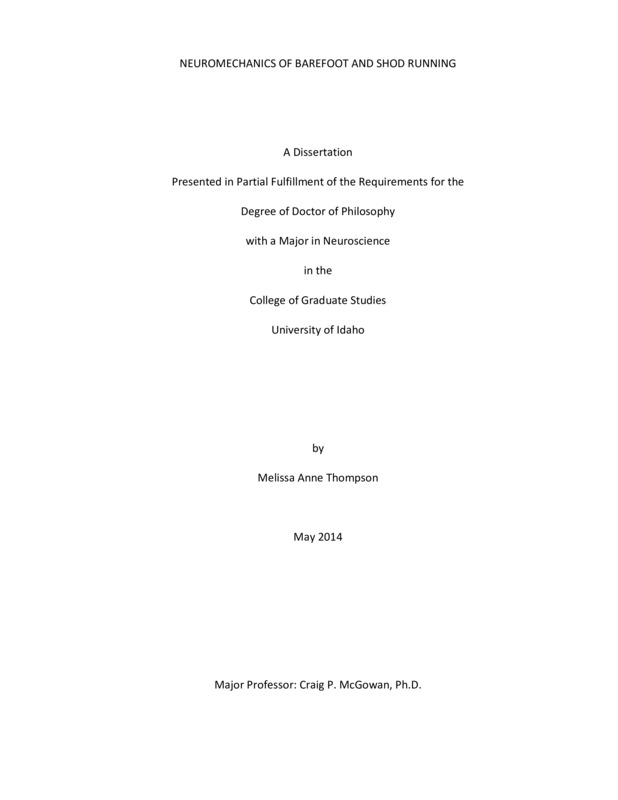NEUROMECHANICS OF BAREFOOT AND SHOD RUNNING
Thompson, Melissa. (2014). NEUROMECHANICS OF BAREFOOT AND SHOD RUNNING. Theses and Dissertations Collection, University of Idaho Library Digital Collections. https://www.lib.uidaho.edu/digital/etd/items/thompson_idaho_0089e_10362.html
- Title:
- NEUROMECHANICS OF BAREFOOT AND SHOD RUNNING
- Author:
- Thompson, Melissa
- Date:
- 2014
- Keywords:
- Barefoot Biomechanics Gait Locomotion Neuromechanics Running
- Program:
- Neuroscience
- Subject Category:
- Biomechanics; Neurosciences
- Abstract:
-
In this dissertation, I integrated empirical biomechanical analyses with detailed musculoskeletal modeling and forward dynamics simulations to gain novel insight into neural and mechanical factors that influence barefoot and shod running. This powerful combination of empirical and theoretical approaches enabled me to directly measure changes in gait mechanics as well as estimate differences in parameters relating to both performance and injury. My research chapters specifically focused on evaluating the effect of shoes, stride-length, and ankle position at ground contact, on and lower extremity kinetics and kinematics. In my first research chapter (Chapter 2), I independently evaluated the effects of shoes and changes in stride length on lower extremity kinetics. I found that reducing stride length resulted in decreased ground reaction forces and joint moments in both barefoot and shod running, while the presence or absence of shoes alone did not affect kinetics. This suggests that running barefoot leads to sensory changes that trigger a reduction in stride length, which leads to a decrease in ground reaction forces and joint moments. For my second research chapter (Chapter 3), I examined how naturally forefoot and naturally rear-foot striking runners adapt to barefoot running. The results of this study showed that natural rear-foot strike runners run similar to natural forefoot runners when running barefoot, and indicates the importance of considering foot strike position when evaluating the effects of barefoot and shod running. In my third research chapter (Chapter 4), I investigated the effects of ankle position and running shoes on running kinetics and impact accelerations. I show that, despite increased GRF impact peak magnitudes in shod running, both barefoot running with forefoot ground contact and shod running with heel contact resulted in reduced impact accelerations as compared to barefoot running with heel contact. In my final research chapter (Chapter 5), I used a detailed musculoskeletal model and forward dynamics simulations to quantify elastic energy stored in the Achilles tendon during forefoot strike and rear-foot strike running. Preliminary results suggest that forefoot strike running results in greater utilization of elastic energy; however, better simulation data is needed before making definitive conclusions.
- Description:
- doctoral, Ph.D., Neuroscience -- University of Idaho - College of Graduate Studies, 2014
- Major Professor:
- McGowan, Craig P
- Committee:
- Seegmiller, Jeffrey G; Vasavada, Anita N; Cohen, Rajal G
- Defense Date:
- 2014
- Identifier:
- Thompson_idaho_0089E_10362
- Type:
- Text
- Format Original:
- Format:
- application/pdf
- Rights:
- In Copyright - Educational Use Permitted. For more information, please contact University of Idaho Library Special Collections and Archives Department at libspec@uidaho.edu.
- Standardized Rights:
- http://rightsstatements.org/vocab/InC-EDU/1.0/

